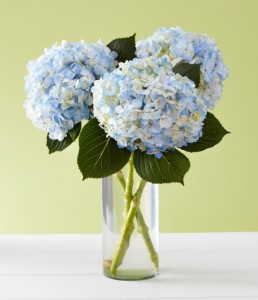All About Hydrangeas
Learn all about hydrangea plants, from where they grow to the meaning behind them.
May 11, 2017
No month is more beloved by gardeners and flower enthusiasts than May. Each May, hundreds of dormant flowers burst into bloom. But no plant or flower comes alive quite like a hydrangea. Seemingly overnight, these wonderfully fragrant flowers open up to expose a cluster of petals, sometimes as large as 8 inches wide.

In honor of these show-stopping plants, here’s everything you need to know about hydrangeas.
History of hydrangeas
Though hydrangeas were first discovered in Japan, hydrangea fossil records (yes, there are plant fossil records!) show that they were actually growing in North America 40 to 65 million years ago. It’s believed that they existed millions of years ago but eventually became extinct in North America. Or at least they were until 1736, when a European colonist brought them to the New World. While this may be the more historic account of how hydrangeas came to the United States, a small town in Illinois believes in a different story.
Local legend has it that a woman named Harriet Kirkpatrick was riding on her horse through the woods of Illinois when she discovered hundreds of white Annabelle Hydrangea bushes in full bloom. Thrilled by her discovery, she went back home to find her sister and show her these magnificent flowers. After the two transplanted them into their garden at home, word quickly spread throughout the town of these “snow-like” plants. Within days, everyone in town had hydrangeas growing in front of their home.
Hydrangea symbols and meanings
Hydrangeas hold different meanings in different cultures.
Japan
In ancient Japan, it’s believed that whenever an emperor did something wrong, he would apologize to his maiden with hydrangeas. Therefore, in Japan, hydrangeas typically symbolize sorrow, regret, or an apology.
Europe
It turns out that in Europe you don’t exactly want to be given hydrangeas, as they are left at the homes of people who are arrogant and rude.
United States

In America, hydrangeas have much happier meanings. Most commonly, they’re associated with familial love and are one of the most popular flower choices for Mother’s Day.
They’re such a popular flower that each color holds its own significance.
- Pink: Love, an emotional connection, romance
- Blue: Forgiveness, sorrow, “my apologies"
- White: Purity, grace, innocence
- Purple: Wealth, royalty, superiority
5 fun hydrangea facts
- There are around 75 species of hydrangeas.
- Hydrangeas grow on every continent, from Asia to North America.
- Don’t let their soft, feminine look deceive you — hydrangeas are notoriously toxic!
- There exists an American Hydrangea Society! Since 1994, hydrangea lovers have gathered to discuss their love of the colorful, bushy plant.
- Some of the tallest hydrangeas in the world grew to an amazing 10 feet tall! But typically they grow to between 2 and 5 feet.
Hydrangea care
The word “hydrangea” comes from the Greek word "hydro," meaning "water." The name was inspired by the constant water that’s needed to care for them.
In addition to plenty of water, here are a few other things you should know about caring for hydrangeas.
- Hydrangeas can thrive in full sun or partly shady areas.
- They should be planted in rich, moist soil.
- Soil pH greatly affects their bloom and coloring, so make sure your soil isn’t too acidic.
- Hydrangeas can live for years without needing to be pruned; however, if you do decide to prune them, you should do it before midsummer.










